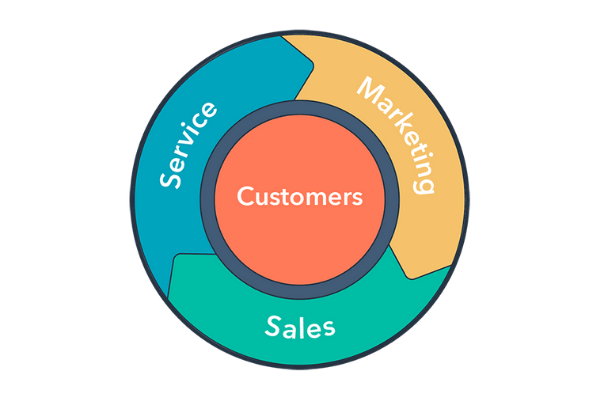One of the many great aspects of HubSpot is that they’re more than just CRM software: they’re a mindset and a philosophy. In the HubSpot model, a company’s internal process and the end customer or user experience are intrinsically connected. Similar to the way that holistic medicine looks at the whole person rather than zeroing in on a single health issue, the HubSpot philosophy asks us to consider how an entire company impacts customer experience, rather than just isolating those concerns with Customer Service reps. That philosophy uses a key metaphor to illustrate its principles: the flywheel.
Funnels Vs. Flywheels
The concept of the funnel in sales and marketing is an old one, dating from the 19th century. Generally speaking, the funnel is a linear set of stages that a business strives to move customers through: awareness, interaction, interest and action.
Here’s how Salesforce illustrates the funnel:

Using an old-school funnel, a business would work to attract as many prospects as possible to the top, filtering them through in hopes that a few of them will make it to the bottom by hitting “Buy now.”
One of the issues with the funnel model is that it was designed before the advent of the Internet and social media. Consumers interact with brands and make decisions about products and services in a completely different way now.
Another problem with the funnel? It’s open at the bottom. After you’ve invested all the time and money to escort a prospect through all of the stages and finally converted them? The journey is over. Your hard-won customer is no longer considered once they’ve taken the action you desired. You don’t need Yelp, Twitter or Google to recognize that strategy has a literal giant hole in it.
Flywheels have been used in human tools at least as far back as the Neolithic spindle and the potter’s wheel. Today, mechanical flywheels are found in internal combustion engines, wind turbines, power hammers, riveting machines and stationary bikes—but if you Google the term, most of your search results will show flywheel as a marketing metaphor.
HubSpot CEO Brian Halligan Introduced the concept of the flywheel in 2018, shaking up both his own company and marketing at large. Though he was initially skeptical of the concept, HubSpot VP of Marketing Jon Dick points out that “Funnels lose the energy you put into them once you reach the bottom, but flywheels are remarkable at storing and releasing energy.”
Instead of the funnel, which digests leads, turns them into customers and disposing them at the end of the process, the flywheel incorporates customers in a circular process where your audience actually spurs growth.

The flywheel centers the customer. Instead of a model that sees the customer start and end their experience with your brand, the flywheel stays engaged with them. By delighting customers and meeting their needs, they’ll advocate for you, which in turn grows your business.
Why Friction is Flywheel Kryptonite
There’s so much more to say about the flywheel concept, but I’ll leave you with this: flywheels require a smooth-running operation to work.
HubSpot is clear that this model requires “eliminating friction from your business strategy:”
“Friction is anything that slows down your flywheel. For example, poor internal processes, lack of communication between teams, or misalignment between your customers and your employees.”
Are your teams working in alignment or are workflows full of potholes? Is your website easy to navigate or is it cluttered with excess information and confusing detours? Is your whole company relying on one data set as a single source of truth or is everyone using their own numbers? All of the above creates friction and results in a substandard customer experience.
The Flywheel is a Key Paradigm Shift
If you think that shifting mindsets as I’ve explained above sounds like a lot of work? You’re right. Revising internal and external processes and strategies isn’t easy— cut its key if you want your business to thrive. The flywheel is a cornerstone of Amazon’s astonishing domination—but it can be used to build nonprofits and create effective cause marketing as well. Think about the last podcast you raved about to a friend, the Netflix series you told your coworkers they absolutely have to see, the candidate whose messaging you shared on your personal Instagram. You play a role in other organizations’ flywheels.
In my experience, the flywheel creates a far healthier and more beneficial approach to operations, company culture and customer relationship management. It’s a shift that requires centering the customer, getting buy-in from your team and fostering their willingness to cooperate—but it’s an investment that today’s brands, businesses and causes can’t afford not to make. As McKinsey points out, it’s simply a better way to build your brand.
Want to know more about reducing friction in your business operations and putting customers at the center of your strategy? Let’s talk!
